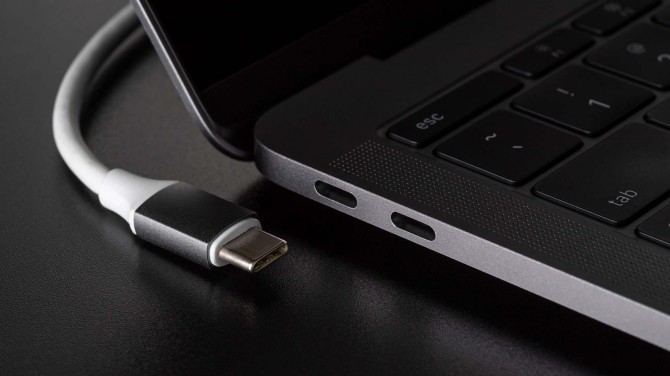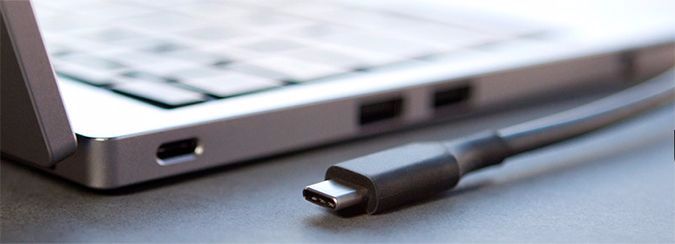USB-C Cable Types: Everything You Need to Know
Since the launch of the 2015 Apple MacBook, the first laptop to feature USB Type-C ports, the versatile port has reached a tipping point. The “do-everything” port that we were promised is now found on virtually every gadgets from laptops and smartphones to wireless headphones and external batteries.
Native USB-C accessories and USB-C monitors are also more commonplace. While USB4 is on the horizon, it’s clear that USB-C will remain the standard connector for years to come. So whether you have been using it since the beginning or are just getting on board now, here’s everything you need to know about USB-C.
Anatomy of USB-C
USB-C describes the connector itself, the rounded rectangle or oval shape with 24 pins on the inside. One of the best features of USB-C over its predecessors is that the plug is reversible, meaning you never have to worry about plugging it in upside down. The 24-pin layout is 3 times what was available on even the later generation USB 3.0 supporting USB-A and MicroUSB plugs. There are three primary pieces to the layout with one supporting the old USB 2.0 standard and two supporting high-speed data. The dual-lane high-speed data architecture is what differentiates USB-C from USB 3.0.
What Can I Do with USB-C?
I’ll get into more of the nuts and bolts of USB-C below, but first, let’s take a look at what you can potentially do with USB-C. As I said at the outset, part of what is so compelling about USB-C is that it can take the place of so many other ports. It was a bit of a pain point for early adopters as laptop manufacturers began replacing legacy ports with USB-C, forcing people to carry dongles or docks to fill the void. However, this is becoming less and less of a concern with more USB-C friendly products.
One of the places that you can really feel the benefits of USB-C is connecting to a USB-C monitor. You can deliver the image to the monitor, have it function as a USB hub and if the monitor has its own power source it will also power your laptop through a single Thunderbolt 3 USB-C cable, it’s a dream docking situation. Using compatible cables and devices, you can expect up to 4K at 60 frames per second to two monitors or 5K at 60fps to a single monitor.
Sign up to receive The Snapshot, a free special dispatch from Laptop Mag, in your inbox.
With the venerable 3.5mm headphone jack rapidly disappearing from smartphones, USB-C can step in as the wired headphone solution for those that aren’t sold on or can’t always rely on Bluetooth options. While earlier versions suffered from a variety of issues including power drain, USB Audio Device Class 3.0, a specification created by the USB Implementers Forum (USB-IF in 2016, brought USB-C audio options more in line with the older 3.5mm standard. It was in direct response to devices dropping the traditional headphone jack and offered standardization around an existing port along with new features like hotword detection and support for noise cancellation.
MORE: USB Type-C FAQ
Not only is USB-C able to supply considerably more power than its predecessors, but it can do so while still transferring data at high speeds over the same cable. Another useful feature with some USB-C devices is bidirectional charging, which allows one device to charge another. An easy example is the Samsung Galaxy Note 10 Plus charging another smartphone.
If you need to boost your laptop’s performance on occasion, a USB-C port that supports Thunderbolt 3 or USB4 will allow you to add an external GPU. That means you don’t need to wedge a massive gaming laptop into your bag if you want to enjoy high-end PC gaming. Similarly thanks to the up to 40Gbps data transfer speeds possible via USB-C you can plug in an external hard drive to vastly expand your storage and see speeds comparable to your internal drive.
USB Protocols
The USB protocol is the crucial piece of information that will let you know what a specific USB-C port or cable can do. At present most USB-C devices and cables support at least USB 3.2 Gen 2, but they can fall back to USB 2.0 and will ultimately be able to support USB4 which should arrive in mid- to late 2020. Here’s a quick overview of those protocols.
USB 2.0
This protocol has been around since 2000 and most will associate it with the familiar and still ubiquitous rectangular USB-A ports or the smaller micro USB ports. While not the most common, it does still pop up in some USB-C cables or adapters, typically the USB-A to USB-C variety. This can cap your data transfer speeds, maxing out at 480Mbps. Additionally charging speeds will be slower with 5 volts at 0.5 amps for a maximum output of 2.5 watts. That makes them less than ideal for charging devices like a modern flagship smartphone and virtually useless for charging a laptop.
USB 3.2 Gen 1 (SuperSpeed USB)
This is where things get a little confusing as this was originally known as USB 3.0 and then USB 3.1 Gen 1, but in early 2019 the USB-IF announced the new naming convention with the release of the 3.2 protocol. Whatever it’s called, it offers a tremendous boost in data speeds from USB 2.0, up to 5Gbps or almost 10 times faster. Charging doesn’t make as significant a leap, but it does nearly double going up to 5 volts at 0.9 amps for a maximum output of 4.5 watts.
USB 3.2 Gen 2 (SuperSpeed USB 10Gbps)
Similar story here on the naming, this was previously known as USB 3.1 and then USB 3.1 Gen 2. As the more consumer-friendly name suggests this protocol doubles the speed from its predecessor with a max of 10Gbps. Again we don’t get quite the same jump on the charging side, but 5 volts at 1.5 amps yields 7.5 watts or about a two-thirds step up. This is where USB-A and USB Micro ports top out.
USB 3.2 Gen 2x2 (SuperSpeed USB 20Gbps)
Only one previous name this time, USB 3.2. As the technical name (SuperSpeed USB 20GBps) suggests, this finally takes advantage of the dual-lane high-speed capabilities of USB-C. Predictably that leads to another speed doubling at up to 20Gbps. We also finally see the same bump on the power front with 5 volts at 3 amps with a maximum output of 15 watts.
USB4
We expect to see USB4 products sometime in 2020 and the headline feature is another data transfer speed doubling with up to 40Gbps. What USB4 will also bring is some additional clarity to USB-C as it integrates Intel’s Thunderbolt technology, something that is only occasionally supported at present and should lead to savings on Thunderbolt accessory pricing going forward. Similarly, USB4 will include USB Power Delivery by default, which can dramatically boost device charging speeds and is inconsistently implemented currently.
What is USB Power Delivery?
For every generation prior to USB4, USB Power Delivery is distinct from the USB protocol, but it has a major impact on device charging with the ability to support 20 volts at 5 amps and a maximum output of 100 watts. It also can optimize power management so that the correct wattager is delivered to one or multiple connected devices. USB-C monitors supporting Power Delivery can provide a charge to the laptop via the same cable that is carrying the image.
While Power Delivery is widely supported, it isn’t the only fast-charging standard out there. The other major player is Qualcomm’s Quick Charge. Notably, the latest version of Quick Charge (4.0+) is also compatible with USB Power Delivery. There are a number of other proprietary standards from individual manufacturers like Samsung’s Adaptive Fast Charging, Oppo’s VOOC, or Huawei’s SuperCharge to name a few, but they are limited to these manufacturers and their chargers.
This is a common point of confusion with USB-C as while Thunderbolt 3 uses a USB-C shaped port, it requires additional hardware versus USB-C. Thunderbolt 3 is capable of the same 40Gbps data transfer that we will see from USB4 starting in 2020, allowing for the use of external GPUs, 4K 60fps video on dual-screens, 5K 60fps on a single screen, and daisy-chaining of devices like multiple external hard drives. Much like USB Power Delivery, this will become less of an issue in 2020 and beyond as USB4 integrates Thunderbolt.
Credit: Shutterstock
Sean Riley has been covering tech professionally for over a decade now. Most of that time was as a freelancer covering varied topics including phones, wearables, tablets, smart home devices, laptops, AR, VR, mobile payments, fintech, and more. Sean is the resident mobile expert at Laptop Mag, specializing in phones and wearables, you'll find plenty of news, reviews, how-to, and opinion pieces on these subjects from him here. But Laptop Mag has also proven a perfect fit for that broad range of interests with reviews and news on the latest laptops, VR games, and computer accessories along with coverage on everything from NFTs to cybersecurity and more.




